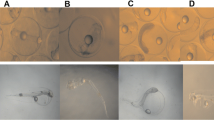Abstract
A series of six 96-h static bioassays were performed to validate the use of anchoveta (Engraulis ringens) embryos as test organisms for ecotoxicological studies. The standardization protocol utilized potassium dichromate (K2Cr2O7) as a reference toxicant and egg mortality as the endpoint. The results indicated that the mean sensitivity of anchoveta embryos to potassium dichromate was 156.1 mg L−1 (range: 131–185 mg L−1). The statistical data analysis showed high homogeneity in LC50 values among bioassays (variation coefficient = 11.02%). These results demonstrated that the protocol and handling procedures implemented for the anchoveta embryo bioassays comply with international standards for intra-laboratory precision. After secondary treatment, an effluent from a modern Kraft pulp mill was tested for E. ringens embryo toxicity, finding no significant differences from the controls.




Similar content being viewed by others
References
Cubillos LA, Ruiz P, Claramunt G, Gacitúa S, Núñez S, Castro LR, Riquelme K, Alarcón C, Oyarzún C, Sepúlveda A (2007) Spawning, daily egg production, and spawning stock biomass estimation for common sardine (Strangomera bentincki) and anchovy (Engraulis ringens) off central southern Chile in 2002. Fish Res 86:228–240. doi:10.1016/j.fishres.2007.06.007
da Cruz A, Couto B, Nascimento I, Pereira S, Leite M, Bertoletti E, Zagatto P (2007) Estimation of the critical effect level for pollution prevention based on oyster embryonic development toxicity test: the search for reliability. Environ Intern 33:589–595. doi:10.1016/j.envint.2006.09.003
Kunz Y (2004) Developmental biology of teleost fishes. Fish and fisheries series. Springer
Llanos-Rivera A, Castro LR (2006) Inter-population differences in temperature effects on Engraulis ringens yolk sac larvae. Mar Ecol Prog Ser 312:245–253. doi:10.3354/meps312245
Losso C, Picote M, Arizzi A, Delaney E, Ghetti P (2007) Developing toxicity scores for embryotoxicity test on elutriates with the sea urchin Paracentrotus lividus, the oyster Crassostrea gigas, and the mussel Mytilus galloprovincialis. Arch Environ Contam Toxicol 53:220–226. doi:10.1007/s00244-006-0136-x
Moser G, Ahlstrom E (1985) Staging anchovy eggs. In: Lasker R (ed) A egg production method for estimating spawning biomass of pelagic fish: application to the northern anchovy, Engraulis mordax. NOAA Technical Report NMFS, vol 36, pp 37–41
OECD (1998) Fish, short term toxicity test on embryo and sac-fry stages. Test guideline 212. OEDC Guideline for testing of chemicals
Raisuddin S, Kwok K, Leung K, Schlenk D, Lee J (2007) The copepod Tigriopus: a promising marine model organism for ecotoxicology and environmental genomics. Aqua Toxicol 83:161–173. doi:10.1016/j.aquatox.2007.04.005
Serra J, Rojas O, Aguayo M, Inostroza F, Cañon J (1979) Anchoveta (Engraulis ringens) In Estado actual de las principales pesquerías nacionales. Bases para un desarrollo pesquero. Corporación de fomento de la producción. Instituto de Fomento Pesquero, Santiago, Chile
Silva A (2001) Advance in the culture research on small-eye flounder Paralichthys microps and chilean flounder Paralichthys adspersus in Chile. J Appl Aquaculture 11:147–164. doi:10.1300/J028v11n01_11
Silva J, Troncoso L, Bay-Schmith E, Larrain A (2001) Utilization of Odontesthes regia (Atherinidae) from the South Pacific as a test organism for bioassays: study of its sensitivity to six chemicals. Bull Environ Contam Toxicol 66:570–575
Tarifeño E, Carmona M, Llanos-Rivera A, Castro LR (2007) Temperature effects on the anchoveta Engraulis ringens egg development: do latitudinal differences occur? Environ Biol Fish 81:387–395. doi:10.1007/s10641-007-9208-7
U.S. EPA (2002a) Methods for measuring the acute toxicity of effluents and receiving waters to fresh water and marine organisms, 5th edn. United States Environmental Protection Agency. Office of water (4303T) 1200 Pennsylvania Avenue, NW Washington, DC 20460. EPA-821-R-02-012
U.S. EPA (2002b) Short-term methods for estiming the chronic toxicity of effluents and receiving waters to marine and estuarine organisms, 3rd edn. United States Environmental Protection Agency. Office of water (4303T) 1200 Pennsylvania Avenue, NW Washington, DC 20460. EPA-821-R-02-014
West Inc., Gulley D (1994) Toxstat version 3.4. Western Ecosystems Technology Inc., Cheyenne WY
Acknowledgments
This research was funded by the Programa de Investigación Marina de Excelencia (PIMEX-Nueva Aldea), Universidad de Concepción – CFI-Nueva Aldea. We also thank S. Soto, A. Yañez, M.C. Krautz, J. Méndez, and M.I. Muñoz from the Laboratorio de Oceanografía Pesquera y Ecologia Larval (LOPEL) for their help with sampling at sea and during egg sorting in the laboratory. Filtered seawater was provided by Dr. E. Tarifeño’s research group at the invertebrate hatchery in the Dichato Marine Station of the Universidad de Concepción.
Author information
Authors and Affiliations
Corresponding author
Rights and permissions
About this article
Cite this article
Llanos-Rivera, A., Castro, L.R., Silva, J. et al. A New Developmental Toxicity Test for Pelagic Fish Using Anchoveta (Engraulis ringens J.). Bull Environ Contam Toxicol 83, 23–28 (2009). https://doi.org/10.1007/s00128-009-9714-8
Received:
Accepted:
Published:
Issue Date:
DOI: https://doi.org/10.1007/s00128-009-9714-8




